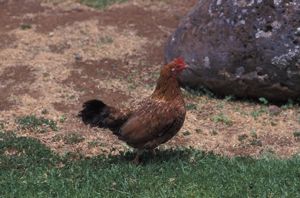The Red Junglefowl (Gallus gallus) has been breeding in Pulau Ubin since the later part of 1980s, although it was first sighted in the early 1970s. Since then the bird has been found in a number of locations on the main island, presumed to be escapees, released birds or even arriving naturally from nearby Johor, Malaysia. But Pulau Ubin is still the best place to view the Red Junglefowl, as Margie Hall’s 11th December 2007 account below testifies:
“Had a lovely view today (Monday 10th) of Red Junglefowl coming out from the coastal forest onto the rocky beach at Chek Jawa, around 5.00 pm. Rain had finally stopped and we were walking along the boardwalk and saw one mixed group of Junglefowl come out and then scuttle behind rocks. A bit further up we saw four males all together in a large patch of green seaweed. At first glance I thought they were foraging, but when I got my bins on them I realised the two in the middle were facing each other, with the feathers around their necks raised up and curved forwards, making a big “ruffle”. There was a little bit of backwards and forwards between them and then the one facing the forest drove the other one back into it. We didn’t see those two any more – the other two carried on standing around whilst we went past. Each of them had been standing behind one of the fighting birds, just like a “second” in a duel.
“Another special sighting was two otters lolloping all along the sandbar in the distance, before going into the sea. But we had barely gone down the ladder onto the sand when torrential rain arrived again and we had to beat a retreat. Still, the junglefowl and the otters made it worthwhile. Especially when, given all the early afternoon rain, it had seemed mad even to carry on with the planned trip. Thanks to the NParks guides and volunteer guide who turned out on such a wet day too.”
Input by Margie Hall, images by YC.










